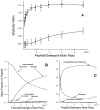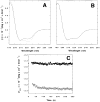pH-dependent tetramerization and amantadine binding of the transmembrane helix of M2 from the influenza A virus
- PMID: 11087364
- PMCID: PMC3060174
- DOI: 10.1021/bi001799u
pH-dependent tetramerization and amantadine binding of the transmembrane helix of M2 from the influenza A virus
Abstract
The M2 proton channel from the influenza A virus is a small protein with a single transmembrane helix that associates to form a tetramer in vivo. This protein forms proton-selective ion channels, which are the target of the drug amantadine. Here, we propose a mechanism for the pH-dependent association, and amantadine binding of M2, based on studies of a peptide representing the M2 transmembrane segment in dodecylphosphocholine micelles. Using analytical ultracentrifugation, we find that the sedimentation curves for the peptide depend on its concentration in the micellar phase. The data are well-described by a monomer-tetramer equilibrium, and the binding of amantadine shifts the monomer-tetramer equilibrium toward tetrameric species. Both tetramerization and the binding of amantadine lead to increases in the magnitude of the ellipticity at 223 nm in the circular dichroism spectrum of the peptide. The tetramerization and binding of amantadine are more favorable at elevated pH, with a pK(a) that is assigned to a His side chain, the only ionizable residue within the transmembrane helix. Our results, interpreted quantitatively in terms of a reversible monomer and tetramer protonation equilibrium model, suggest that amantadine competes with protons for binding to the deprotonated tetramer, thereby stabilizing the tetramer in a slightly altered conformation. This model accounts for the observed inhibition of proton flux by amantadine. Additionally, our measurements suggest that the M2 tetramer is substantially protonated at neutral pH and that both singly and doubly protonated states could be involved in M2's proton conduction at more acidic pHs.
Figures












Similar articles
-
Sequence determinants of a transmembrane proton channel: an inverse relationship between stability and function.J Mol Biol. 2005 Mar 18;347(1):169-79. doi: 10.1016/j.jmb.2005.01.023. Epub 2005 Jan 21. J Mol Biol. 2005. PMID: 15733926
-
Protonation of histidine and histidine-tryptophan interaction in the activation of the M2 ion channel from influenza a virus.Biochemistry. 2001 May 22;40(20):6053-60. doi: 10.1021/bi0028441. Biochemistry. 2001. PMID: 11352741
-
Total chemical synthesis of the integral membrane protein influenza A virus M2: role of its C-terminal domain in tetramer assembly.Biochemistry. 1999 Sep 14;38(37):11905-13. doi: 10.1021/bi990720m. Biochemistry. 1999. PMID: 10508393
-
Structural and dynamic mechanisms for the function and inhibition of the M2 proton channel from influenza A virus.Curr Opin Struct Biol. 2011 Feb;21(1):68-80. doi: 10.1016/j.sbi.2010.12.002. Epub 2011 Jan 17. Curr Opin Struct Biol. 2011. PMID: 21247754 Free PMC article. Review.
-
Proton conduction through the M2 protein of the influenza A virus; a quantitative, mechanistic analysis of experimental data.FEBS Lett. 2003 Sep 18;552(1):17-22. doi: 10.1016/s0014-5793(03)00778-6. FEBS Lett. 2003. PMID: 12972146 Review.
Cited by
-
How do helix-helix interactions help determine the folds of membrane proteins? Perspectives from the study of homo-oligomeric helical bundles.Protein Sci. 2003 Apr;12(4):647-65. doi: 10.1110/ps.0236503. Protein Sci. 2003. PMID: 12649422 Free PMC article. Review.
-
Use of thiol-disulfide equilibria to measure the energetics of assembly of transmembrane helices in phospholipid bilayers.Proc Natl Acad Sci U S A. 2003 Dec 9;100(25):14772-7. doi: 10.1073/pnas.2536751100. Epub 2003 Dec 1. Proc Natl Acad Sci U S A. 2003. PMID: 14657351 Free PMC article.
-
Nanosecond Dynamics of InfluenzaA/M2TM and an Amantadine Resistant Mutant Probed by Time-Dependent Red Shifts of a Native Tryptophan.Chem Phys. 2013 Aug 30;422:10.1016/j.chemphys.2012.12.018. doi: 10.1016/j.chemphys.2012.12.018. Chem Phys. 2013. PMID: 24273370 Free PMC article.
-
Affinity of Rimantadine Enantiomers against Influenza A/M2 Protein Revisited.ACS Med Chem Lett. 2017 Jan 27;8(2):145-150. doi: 10.1021/acsmedchemlett.6b00311. eCollection 2017 Feb 9. ACS Med Chem Lett. 2017. PMID: 28217261 Free PMC article.
-
Structural basis for proton conduction and inhibition by the influenza M2 protein.Protein Sci. 2012 Nov;21(11):1620-33. doi: 10.1002/pro.2158. Epub 2012 Oct 9. Protein Sci. 2012. PMID: 23001990 Free PMC article. Review.
References
-
- Lamb RA, Holsinger LJ, Pinto LH. In: Receptor-Mediated Virus Entry into Cells. Wimmer E, editor. Cold Spring Harbor Laboratory Press; Cold Spring Harbor, NY: 1994. pp. 303–321.
-
- Duff KC, Kelly SM, Price NC, Bradshaw JP. FEBS Lett. 1992;311:256–258. - PubMed
-
- Duff KC, Gilchrist PJ, Saxena AM, Bradshaw JP. Virology. 1994;202:287–293. - PubMed
Publication types
MeSH terms
Substances
Grants and funding
LinkOut - more resources
Full Text Sources
Other Literature Sources

